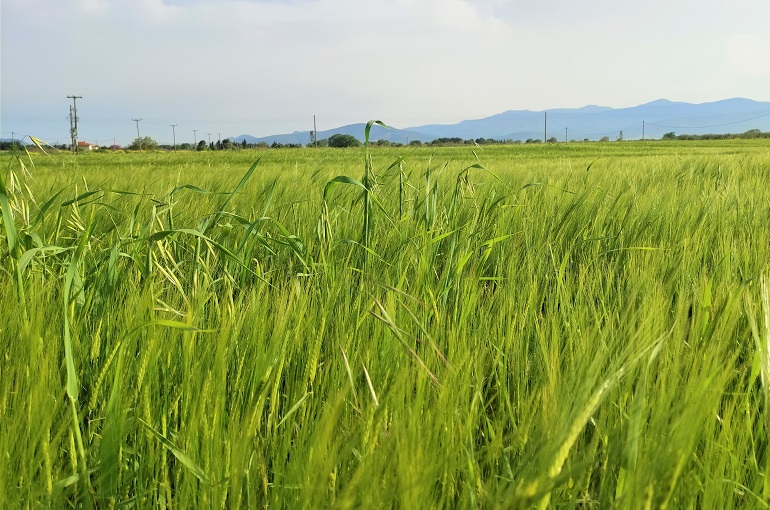Barley Pests and Diseases

This post is also available in:
This post is also available in:
![]() Español (Spanish)
Español (Spanish) ![]() Français (French)
Français (French) ![]() Deutsch (German)
Deutsch (German) ![]() Nederlands (Dutch)
Nederlands (Dutch) ![]() हिन्दी (Hindi)
हिन्दी (Hindi) ![]() العربية (Arabic)
العربية (Arabic) ![]() Türkçe (Turkish)
Türkçe (Turkish) ![]() 简体中文 (Chinese (Simplified))
简体中文 (Chinese (Simplified)) ![]() Ελληνικά (Greek)
Ελληνικά (Greek) ![]() Português (Portuguese (Brazil))
Português (Portuguese (Brazil)) ![]() polski (Polish)
polski (Polish)
Barley cultivations are often threatened by external factors such as pests and diseases. If control measures are not taken in time, significant yield losses will occur. Τo better protect our plants, we must get to know the enemies’ profiles in-depth.
The pests that threaten barley are mainly insects (1):
- Aphids (Bird cherry-oat aphid, Russian wheat aphid, Corn leaf aphid, etc.) – Rhopalosuphum padi, Diuraphis noxia, Sitobion avenae
Symptoms→Yellow or white-streaked leaves, purple color of plants in cold weather
Usually, aphids survive on several plants as eggs and they can use more than one plants as hosts. During the spring, young wingless aphids are born from eggs and a new generation is born every 3 to 4 weeks.
- Armyworms (Armyworm, Western striped armyworm) – Mythimna unipunctata, Spodoptera praefica
Symptoms→Eaten leaves
Usually they survive in soil as larvae. During late spring and early summer, the first set of young armyworms is born, while the second comes in late summer. The first one causes the greatest damage. The stages of growth are: egg-larvae-pupae-adult.
- Barley mealybug (Haanchen mealybug) – Trionymus haancheni
Symptoms→Yellow and brown stems
- Stinkbugs – Euschistus
Symptoms→Head damage during milking of soft dough stage
- Wireworms – Aeolus , Anchastus spp., Melanotus spp., Limonium spp.
Symptoms→Seedlings death, whiteheads
Some measures against pests infections could be chemical or biological control, as well as rotation with non-host crops. However, nowadays that is more urgent than ever to adopt sustainable farming practices, experts strongly recommend using integrated pest management (IPM). “Integrated Pest Management (IPM) is an effective and environmentally sensitive approach to pest management that relies on a combination of common-sense practices. IPM programs use current, comprehensive information on the life cycles of pests and their interaction with the environment” (2).
The diseases that threaten barley can be bacterial, viral, or fungal and can affect every part of the barley plant, from root to heads (1,4). Αs experts explain, the severity of the disease is influenced by three main factors; the pathogen, the host, and the environment, creating a triangle (3). Alteration to any of these disease triangle components will influence the disease level.
Bacterial diseases
- Bacterial blight (Bacterial leaf blight, Black chaff) – Xanthomonas translucens, also known as Xanthomonas campestris
Symptoms→Shriveling dead leaves, slow plant growth
The responsible bacterium survives in soil and water and can be transmitted by wind-driven rain droplets. It can also survive on seeds, crop residue, cereals that have been sown in fall, and perennial grasses.
- Basal glume rot – Pseudomonas syringae
Symptoms→Leaves with yellow and necrotic spots
Viral diseases
- Barley stripe – Pyrenophora graminea
Symptoms→Leaves with small yellow spots
It’s a seed-born and monocyclic disease. Usually, it overwinters in sclerotia on crop debris, as reported in Russia. Secondary infection by conidia can lead to floral infection and seed contamination.
- Barley yellow dwarf – Barley yellow dwarf virus (BYDV)
Symptoms→Leaf tip, leaf margin, or leaf blade with yellow-green blotches
Fungal diseases
- Common root rot – Bipolaris sorokiniana, Cochliobolus sativus, Fusarium culmorum, Fusarium graminearum
Symptoms→Lower leaves death
It can occur either from soil-borne spores or from seed-borne inoculum. The spores can survive for many years before germinating. Optimum fertilization levels can reduce disease severity.
- Covered smut – Ustilago hordei
Symptoms→Late emergence of heads
- Downy mildew – Sclerophthora rayssiae
Symptoms→Dwarfed and/or deformed plants
- Ergot – Claviceps purpurea
Symptoms→Dirty heads and kernels that turn into a black mass of fungal mycelia
- Eyespot (foot rot) – Pseudocercosporella herpotrichoides orTapesia yallundae
Symptoms→Stems shriveled and/or collapsing
- Fusarium head blight (FHB or scab) – Fusarium graminearum
Symptoms→Florets bleaching in the spike
- Loose smut – Ustilago nuda, Ustilago tritici
Symptoms→Early emergence of heads
- Net blotch – Pyrenophora teres
Symptoms→Dark green water-soaked spots
- Powder mildew – Blumeria graminis
Symptoms→White lower leaf surface
The most common measures that growers can take to prevent the infection of their plants are:
- Resistant varieties
- Crop rotation
- Weed management
- Remove-Management of crop residues
- Use of certified seeds and/or adequately treated seeds
However, these are just some general guidelines that should not be followed without doing your research. There are no two identical fields in the world; thus, nobody can advise you on crop protection methods without considering your crop’s unique characteristics.
References
- https://plantvillage.psu.edu/topics/barley/infos#!
- https://www.epa.gov/safepestcontrol/integrated–pest–management–ipm–principles#:~:text=Integrated%20Pest%20Management%20(IPM)%20is,their%20interaction%20with%20the%20environment.
- https://grdc.com.au/resources–and–publications/grownotes/crop–agronomy/northernbarleygrownotes/GrowNote–Barley–North-9-Diseases.pdf
- https://grdc.com.au/resources–and–publications/grownotes/crop–agronomy/barley–west/GrowNote–Barley–West-2-Pre–planting.pdf
Barley History, Plant Information, and Nutritional Value
Principles for selecting the best Barley Variety
Barley Soil preparation, Soil requirements, and Seeding requirements
Barley Irrigation Requirements and Methods
Barley Fertilization Requirements and Methods
Barley Pests and Diseases








































































